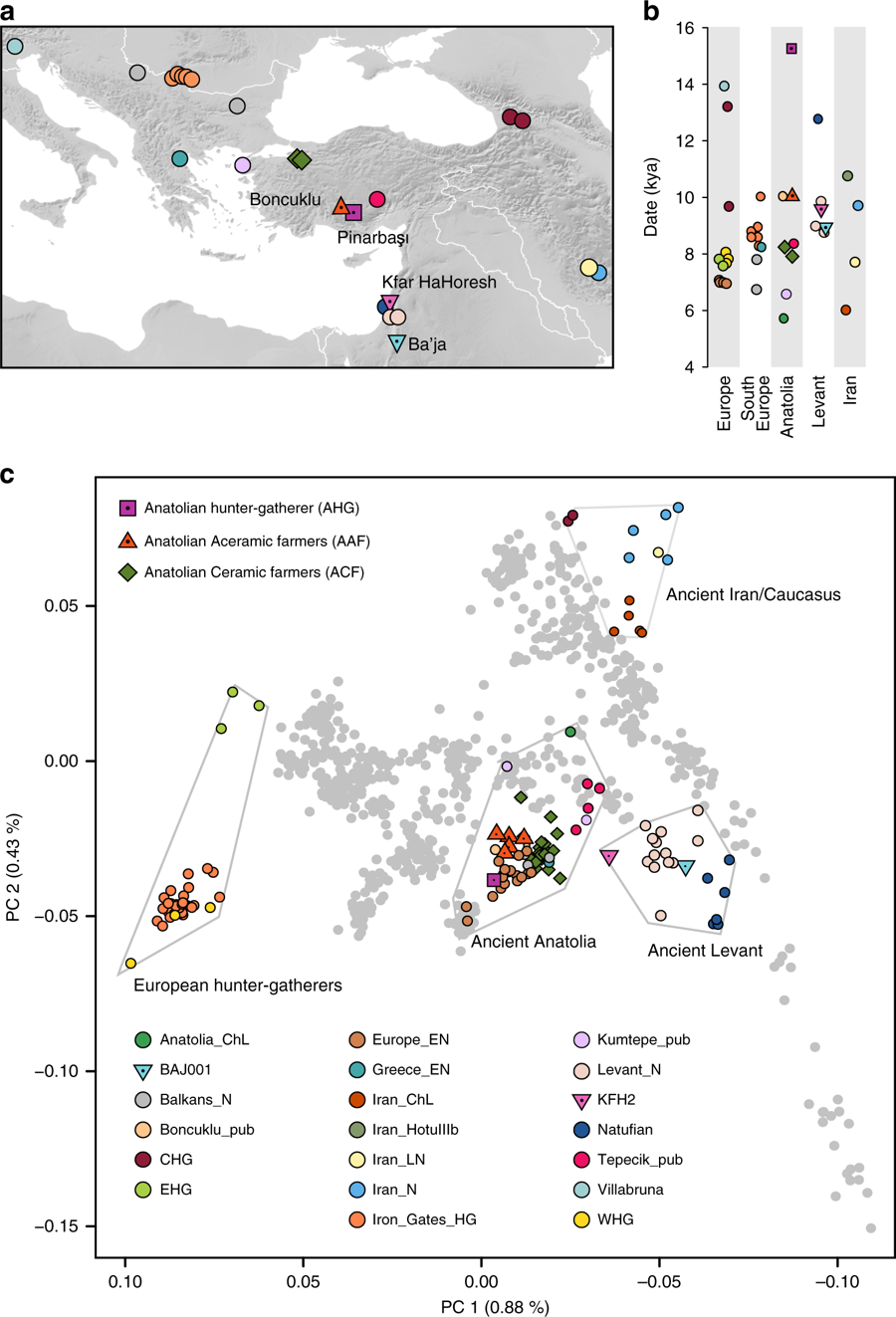-
-
Notifications
You must be signed in to change notification settings - Fork 3
https://en.wikipedia.org/wiki/Anatolian_hunter-gatherers
Anatolian hunter-gatherers (AHG) were a human Epipaleolithic population that inhabited central Anatolia around 13,642-13,073 BCE. This population constitutes the main ancestral genetic contribution of the present-day Europeans:
https://en.wikipedia.org/wiki/Early_European_Farmers
This population is genetically differentiated from the rest of the known Pleistocene populations.
It has been discovered[1] that populations of the Anatolian Neolithic derive a significant portion of their ancestry from the AHG, suggesting that agriculture was adopted in situ by these hunter-gatherers and not spread by demic diffusion into the region.
However they seem to be not too far separated from Levantine influences/ancestors:
Do these three clusters correspond to the three 'tribes' in the Bible and to archaeological cultures?
The Kfar HaHoresh Individuum is of high significance, a PPNA regional funerary center
If the green Anatolian ChL Individuum turns out to be R1 it is a (representative) key figure in joining the distinct branch of Caucasian/Iranian ancestors.
Genome lives on, lineages died out:
The individual analyzed belongs to haplogroup C1a2 of the Y chromosome, which has been found in some of the early WHG's. It has also been observed that this individual belongs to the mitocondrial haplogroup K2b. Both paternal and maternal lineages are rare in the current Eurasian populations.
EEFs had initially spread agriculture throughout Europe largely without admixture with local WHGs.
At the onset of the Chalcolithic the picture becomes more complicated because of increased mobility.
During Late Neolithic and Bronze Age, a dramatic sex-bias was detected, suggesting heavy mixing between migrating males with steppe-related ancestry and local females with EEF ancestry. Not exclusive: increases in hunter-gatherer ancestry during the Middle Neolithic appeared to be largely the result of males with hunter-gatherer ancestry mixing with females with EEF ancestry. Middle Neolithic Europeans overwhelmingly carried hunter-gatherer paternal lineages and EEF maternal lineages. Hunter-gatherer ancestry was even higher among Late Neolithic samples from the Cucuteni–Trypillia culture, Funnelbeaker culture and Globular Amphora culture, which carried about 75-80% EEF ancestry while being dominated by hunter-gatherer paternal lineages.
Reflected in the tradition of traveling girls?
In the southern Balkans, the Middle Neolithic farmers display reduced levels of EEF ancestry increased amounts of ancestry related to Caucasian Hunter-Gatherers (CHGs), suggesting further gene flow from Anatolia, which continued into the Bronze Age.
During the Bronze Age Iberia experienced a significant genetic turnover, with 100% of the paternal ancestry and 40% of the overall ancestry being replaced by peoples with steppe-related ancestry.
A massacre of early Neolithic farmers in the high Pyrenees
EEF from Iberia almost entirely replaced the native Irish Hunter-Gatherers through a rapid maritime colonization. Peoples of the Irish and British Neolithic carried almost entirely the paternal haplogroup I-M284, suggesting that these societies were strongly patrilineal. A Neolithic royal buried at Newgrange was found to be highly inbred and possibly the product of an incestual relationship, suggesting that this community was highly socially stratified and dominated by a line of powerful "god-kings"
Home | Alphabet | Grammar | Gardiner-signs
Home
preserved words
PIE
Inventions
Kur
Signs
Keyboard
Dictionary
Swadesh lists
Text Corpus
Axioms
Grammar
Pronouns
Numbers
Highlights
Cosmos
Gothic
Akkadian
determinatives
+
| äЯ | 𓄿 |
|---|---|
| A | 𓂝 |
| b | 𓃀 |
| c | 𓍿 |
| D | 𓏏 |
| δ | 𓂧 |
| E | 𓇋 |
| F | 𓇋𓆑 |
| G | 𓎼𓐍 |
| h | 𓉔 |
| I | 𓇋 |
| J | 𓆓 |
| K | 𓎡𓌨𓐍 |
| L | 𓏯𓃭 |
| M | 𓅓 |
| N | 𓈖 |
| ϱ | 𓍢𓍯 |
| P | 𓊪 |
| Q | 𓏘 |
| R | 𓂋 |
| S | 𓋴 |
| T | 𓏏 𓎀 |
| ṳ | 𓅱𓍢 |
| V | 𓆑 |
| W | 𓅳 |
| X | 𓎛 |
| Y | 𓏭 |
| Z | 𓊃 𓎀 |
| SH | 𓈙 |
